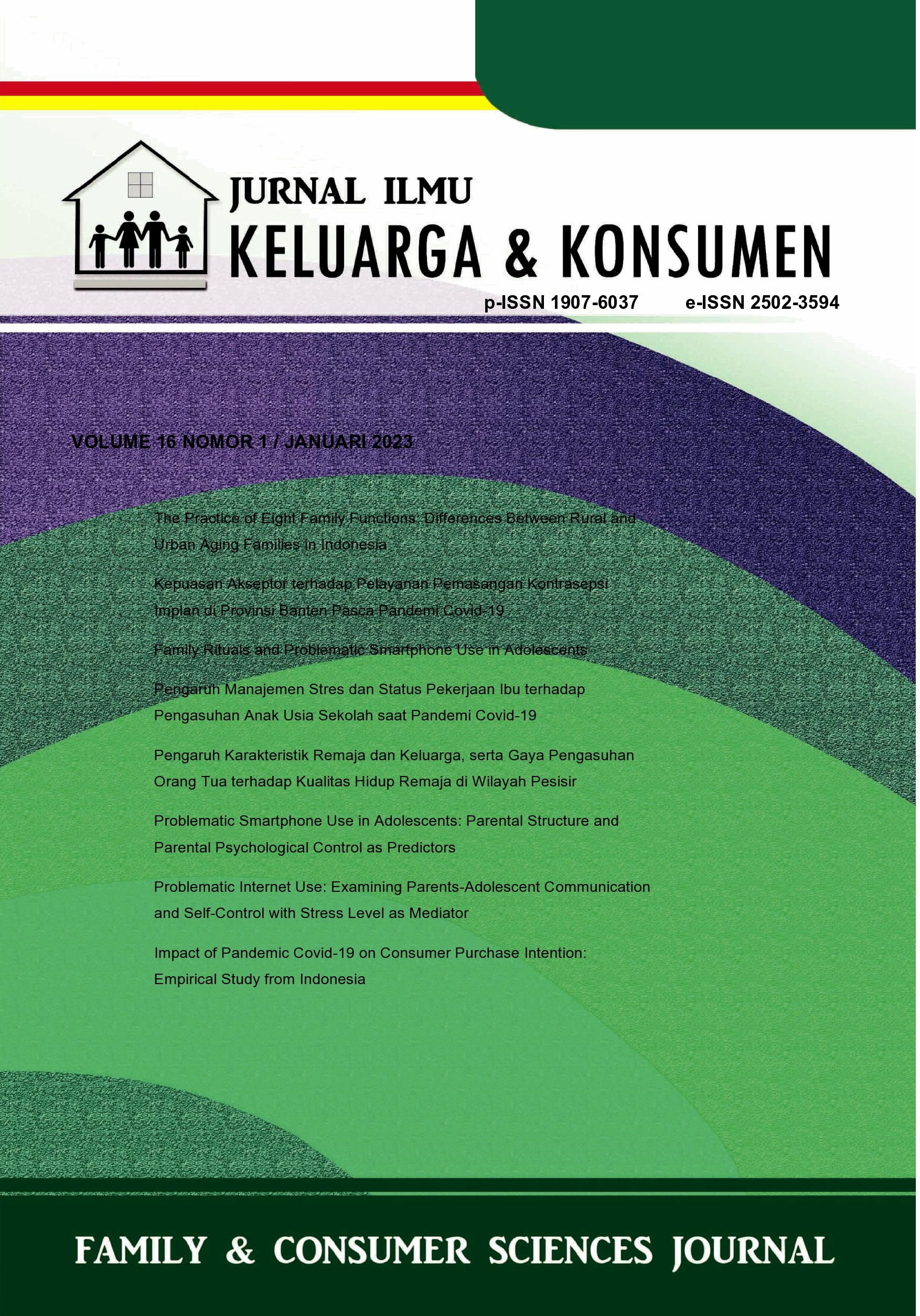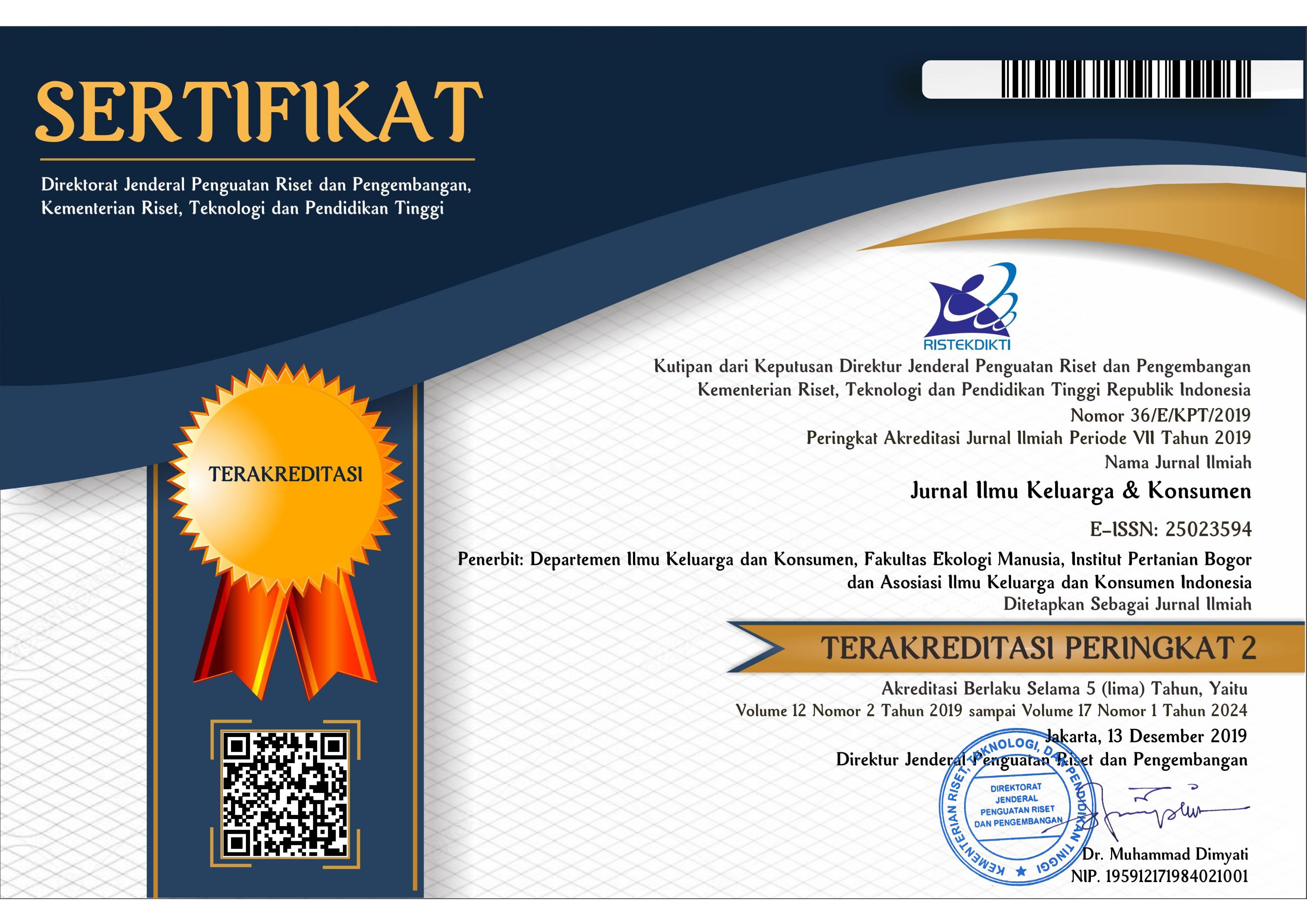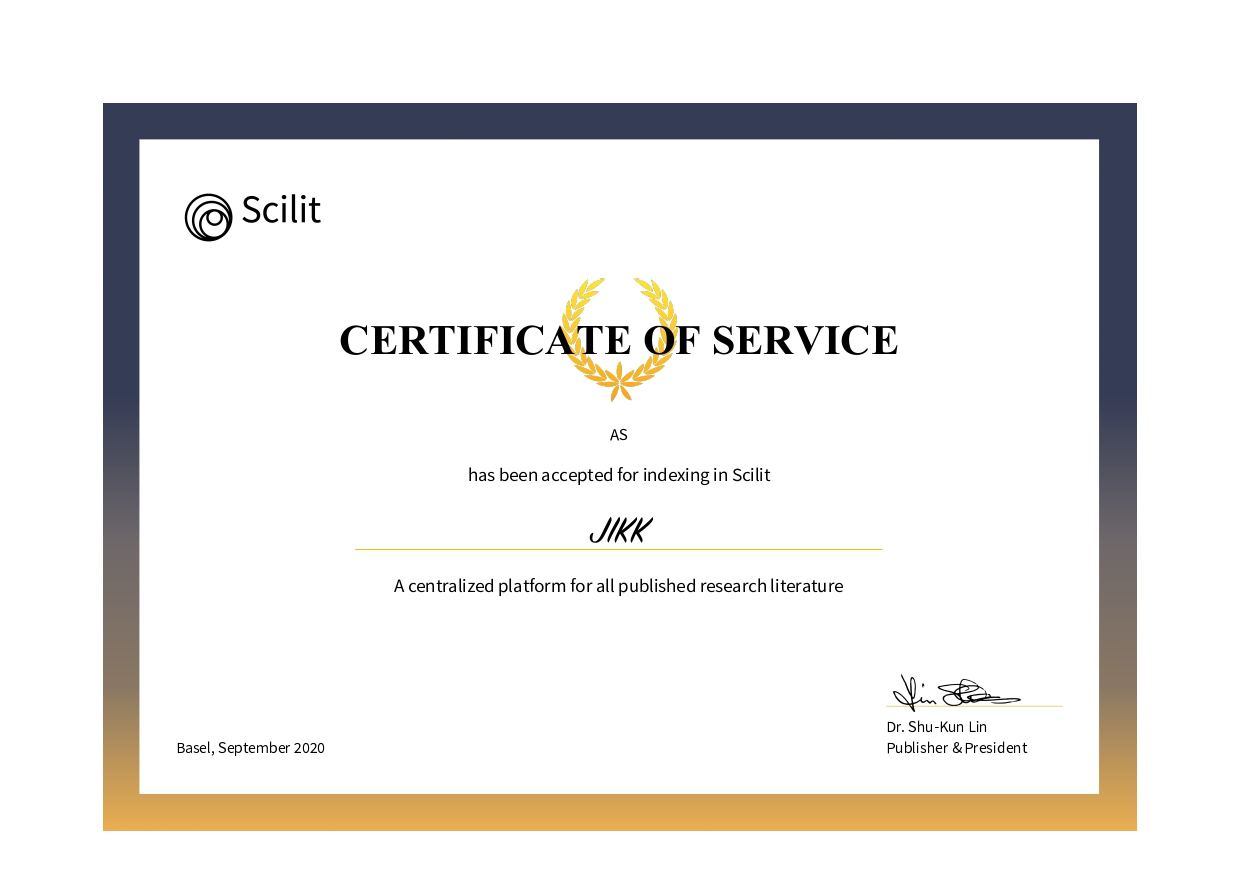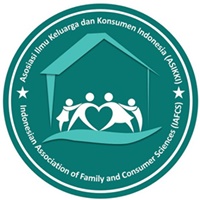FAMILY RITUALS AND PROBLEMATIC SMARTPHONE USE IN ADOLESCENTS
Abstract
Family factors have been identified as potential protective or risk factors for problematic smartphone use in adolescents, yet studies on family rituals as one of the important family factors are scarce. Therefore, this study investigates the relationship between family rituals and problematic smartphone use in adolescents. Family rituals were measured using the Family Ritual Questionnaire (FRQ), and problematic smartphone use was measured using the Mobile Phone Problematic Use Scale (MPPUS). Both measurements were validated in the Indonesian version. Using a cross-sectional approach, we applied a convenience sampling method. Two hundred and twelve adolescents aged 12-18 (girls= 113, boys= 98; Mean age= 14.56, SD= 1.41) participated in this study. The data was analyzed using Spearman’s rho correlation analysis. The results show no significant correlation between family rituals and problematic smartphone use in adolescents (r = 0.01; p > 0.05). Further investigation involving family communication as a mediating variable is strongly recommended.
References
Akhlaq, A., Malik, N. I., & Khan, N. A. (2013). Family communication and family system as the predictor of family satisfaction in adolescents. Science Journal of Psychology, 63(3), 130–136. https://doi.org/10.7237/sjpsych/258
Alsalameh, A., Harisi, M., Alduayji, M., Almutham, A., & Mahmood, F. (2019). Evaluating the relationship between smartphone addiction/overuse and musculoskeletal pain among medical students at Qassim University. Journal of Family Medicine and Primary Care, 8(9), 2953. https://doi.org/10.4103/jfmpc.jfmpc_665_19
American Psychiatric Association. (2013). Diagnostic and statistical manual of mental disorders (5th ed.). https://doi.org/10.1176/appi.books.9780890425596
Asosiasi Penyelenggara Jasa Internet Indonesia. (2020). Laporan survei internet APJII 2019 – 2020. Retrieved from https://apjii.or.id/survei
Badan Pusat Statistik. (2022). Proporsi individu yang menguasai/memiliki telepon genggam menurut kelompok umur (persen), 2019-2021. Retrieved from https://www.bps.go.id/indicator/27/1222/1/proporsi-individu-yang-menggunakan-telepon-genggam-menurut-kelompok-umur.html
Baxter, J. (2018). Who do adolescents spend their time with? Growingupinaustralia.gov.au. Retrieved from https://growingupinaustralia.gov.au/research-findings/annual-statistical-report-2017/who-do-adolescents-spend-their-time
Baxter, L. A., & Clark, C. L. (1996). Perceptions of family communication patterns and the enactment of family rituals. Western Journal of Communication, 60(3), 254–268. https://doi.org/10.1080/10570319609374546
Beranuy, M., Oberst, U., Carbonell, X., & Chamarro, A. (2009). Problematic Internet and mobile phone use and clinical symptoms in college students: The role of emotional intelligence. Computers in Human Behavior, 25(5), 1182–1187. https://doi.org/10.1016/j.chb.2009.03.001
Best, P., Manktelow, R., & Taylor, B. (2014). Online communication, social media and adolescent wellbeing: A systematic narrative review. Children and Youth Services Review, 41, 27–36. https://doi.org/10.1016/j.childyouth.2014.03.001
Cha, S.-S., & Seo, B.-K. (2018). Smartphone use and smartphone addiction in middle school students in Korea: Prevalence, social networking service, and game use. Health Psychology Open, 5(1), 205510291875504. https://doi.org/10.1177/2055102918755046
Dwyer, R. J., Kushlev, K., & Dunn, E. W. (2018). Smartphone use undermines enjoyment of face-to-face social interactions. Journal of Experimental Social Psychology, 78, 233–239. https://doi.org/10.1016/j.jesp.2017.10.007
Eaker, D. G., & Walters, L. H. (2002). Adolescent satisfaction in family rituals and psychosocial development: A developmental systems theory perspective. Journal of Family Psychology, 16(4), 406–414. https://doi.org/10.1037/0893-3200.16.4.406
Elhai, J. D., Dvorak, R. D., Levine, J. C., & Hall, B. J. (2017). Problematic smartphone use: A conceptual overview and systematic review of relations with anxiety and depression psychopathology. Journal of Affective Disorders, 207, 251–259. https://doi.org/10.1016/j.jad.2016.08.030
Fiese, B. H. (1992). Dimensions of family rituals across two generations: Relation to adolescent identity. Family Process, 31(2), 151–162. https://doi.org/10.1111/j.1545-5300.1992.00151.x
Fiese, B. H., & Kline, C. A. (1993). Development of the family ritual questionnaire: Initial reliability and validation studies. Journal of Family Psychology, 6(3), 290–299. https://doi.org/10.1037/0893-3200.6.3.290
Fiese, B. H., Tomcho, T. J., Douglas, M., Josephs, K., Poltrock, S., & Baker, T. (2002). A review of 50 years of research on naturally occurring family routines and rituals: Cause for celebration? Journal of Family Psychology, 16(4), 381–390. https://doi.org/10.1037/0893-3200.16.4.381
Guo, N., Wang, M. P., Luk, T. T., Ho, S. Y., Fong, D. Y. T., Chan, S. S., & Lam, T. H. (2019). The association of problematic smartphone use with family well-being mediated by family communication in Chinese adults: A population-based study. Journal of Behavioral Addictions, 8(3), 412–419. https://doi.org/10.1556/2006.8.2019.39
Hasanah, R. A., & Latifah, M. (2021). Investigasi online resilience remaja: Eksplanasi peranan karakteristik remaja, karakteristik keluarga, kelekatan remaja-orang tua, regulasi emosi, dan hubungan persahabatan. Jurnal Ilmu Keluarga dan Konsumen, 14(3), 270–281. https://doi.org/10.24156/jikk.2021.14.3.270
Haug, S., Castro, R. P., Kwon, M., Filler, A., Kowatsch, T., & Schaub, M. P. (2015). Smartphone use and smartphone addiction among young people in Switzerland. Journal of Behavioral Addictions, 4(4), 299–307. https://doi.org/10.1556/2006.4.2015.037
Hawi, N. S., & Samaha, M. (2017). Relationships among smartphone addiction, anxiety, and family relations. Behaviour & Information Technology, 36(10), 1046–1052. https://doi.org/10.1080/0144929x.2017.1336254
Henneberger, A. K., Gest, S. D., & Zadzora, K. M. (2019). Preventing adolescent substance use: A content analysis of peer processes targeted within universal school-based programs. The Journal of Primary Prevention, 40(2), 213–230. https://doi.org/10.1007/s10935-019-00544-5
Horwood, S., & Anglim, J. (2018). Personality and problematic smartphone use: A facet-level analysis using the Five Factor Model and HEXACO frameworks. Computers in Human Behavior, 85, 349–359. https://doi.org/10.1016/j.chb.2018.04.013
Horwood, S., & Anglim, J. (2019). Problematic smartphone usage and subjective and psychological well-being. Computers in Human Behavior, 97, 44–50. https://doi.org/10.1016/j.chb.2019.02.028
Huang, S., Lai, X., Xue, Y., Zhang, C., & Wang, Y. (2021). A network analysis of problematic smartphone use symptoms in a student sample. Journal of Behavioral Addictions, 9(4), 1032–1043. https://doi.org/10.1556/2006.2020.00098
Jamil, R. A., Gunarya, A., & Kusmarini, D. (2019). Ritual keluarga sebagai diskriminan keberfungsian keluarga. Jurnal Psikologi Sosial, 17(1), 46–56. https://doi.org/10.7454/jps.2019.7
Kalhori, S. M., Mohammadi, M. R., Alavi, S. S., Jannatifard, F., Sepahbodi, G., Reisi, M. B., Sajedi, S., Farshchi, M., KhodaKarami, R., Kasvaee, V. H. (2015). Validation and psychometric properties of mobile phone problematic use scale (MPPUS) in university students of Tehran. Iranian J Psychiatry, 10(1), 25–31.
Kim, D., & Jahng, K. E. (2019). Children’s self-esteem and problematic smartphone use: The moderating effect of family rituals. Journal of Child and Family Studies, 28(12), 3446–3454. https://doi.org/10.1007/s10826-019-01526-1
Kim, H.-J., Min, J.-Y., Min, K.-B., Lee, T.-J., & Yoo, S. (2018). Relationship among family environment, self-control, friendship quality, and adolescents’ smartphone addiction in South Korea: Findings from nationwide data. PLOS ONE, 13(2), e0190896. https://doi.org/10.1371/journal.pone.0190896
Kwon, M., Lee, J.-Y., Won, W.-Y., Park, J.-W., Min, J.-A., Hahn, C., … Kim, D.-J. (2013). Development and Validation of a Smartphone Addiction Scale (SAS). PLoS ONE, 8(2), e56936. https://doi.org/10.1371/journal.pone.0056936
Lee, E. J., & Ogbolu, Y. (2018). Does parental control work with smartphone addiction? Journal of Addictions Nursing, 29(2), 128–138. https://doi.org/10.1097/jan.0000000000000222
Lee, S.-Y., Lee, D.-H., & Han, S.-K. (2016). The effects of posture on neck flexion angle while using a smartphone according to duration. Journal of the Korean Society of Physical Medicine, 11(3), 35–39. https://doi.org/10.13066/kspm.2016.11.3.35
Lee, Y.-K., Chang, C.-T., Lin, Y., & Cheng, Z.-H. (2014). The dark side of smartphone usage: Psychological traits, compulsive behavior and technostress. Computers in Human Behavior, 31, 373–383. https://doi.org/10.1016/j.chb.2013.10.047
Lenhart, A. (2015). Teens, technology and friendships. Pew Research Center: Internet, Science & Tech; Pew Research Center: Internet, Science & Tech. https://www.pewresearch.org/internet/2015/08/06/teens-technology-and-friendships/
Li, W., Garland, E. L., & Howard, M. O. (2014). Family factors in Internet addiction among Chinese youth: A review of English- and Chinese-language studies. Computers in Human Behavior, 31, 393–411. https://doi.org/10.1016/j.chb.2013.11.004
Liu, C.-H., Lin, S.-H., Pan, Y.-C., & Lin, Y.-H. (2016). Smartphone gaming and frequent use pattern associated with smartphone addiction. Medicine, 95(28), e4068. https://doi.org/10.1097/md.0000000000004068
Liu, Q.-Q., Zhou, Z.-K., Yang, X.-J., Kong, F.-C., Niu, G.-F., & Fan, C.-Y. (2017). Mobile phone addiction and sleep quality among Chinese adolescents: A moderated mediation model. Computers in Human Behavior, 72, 108–114. https://doi.org/10.1016/j.chb.2017.02.042
Loue, S. (2017). Handbook of religion and spirituality in social work practice and research. Imprint Springer.
Maimaiti, M., Zhao, X., Jia, M., Ru, Y., & Zhu, S. (2018). How we eat determines what we become: opportunities and challenges brought by food delivery industry in a changing world in China. European Journal of Clinical Nutrition, 72(9), 1282–1286. https://doi.org/10.1038/s41430-018-0191-1
Malaquias, S., Crespo, C., & Francisco, R. (2014). How do adolescents benefit from family rituals? Links to social connectedness, depression and anxiety. Journal of Child and Family Studies, 24(10), 3009–3017. https://doi.org/10.1007/s10826-014-0104-4
Mangialavori, S., Russo, C., Jimeno, M. V., Ricarte, J. J., D’Urso, G., Barni, D., & Cacioppo, M. (2021). Insecure attachment styles and unbalanced family functioning as risk factors of problematic smartphone use in Spanish young adults: A relative weight analysis. European Journal of Investigation in Health, Psychology and Education, 11(3), 1011–1021. https://doi.org/10.3390/ejihpe11030075
Marciano, L., Driver, C. C., Schulz, P. J., & Camerini, A.-L. (2022). Dynamics of adolescents’ smartphone use and well-being are positive but ephemeral. Scientific Reports, 12(1), 1316. https://doi.org/10.1038/s41598-022-05291-y
Mcgoldrick, M., Carter, E. A., & Garcia-Preto, N. (2016). The expanding family life cycle: Individual, family, and social perspectives (5th ed.). Pearson Education, Inc.
Nielsen, P., Favez, N., & Rigter, H. (2020). Parental and Family Factors Associated with Problematic Gaming and Problematic Internet Use in Adolescents: a Systematic Literature Review. Current Addiction Reports, 365–386. https://doi.org/10.1007/s40429-020-00320-0
Quaresma, A. U. M. (2017). Technologies are coming over for dinner: Do ritual participation and meaning mediate effects on family life? (Master’s thesis). University of Lisbon, Lisbon, Portugal.
Santrock, J. W. (2019). A topical approach to life-span development (10th ed.). Mcgraw-Hill Education.
Shi, X., Wang, J., & Zou, H. (2017). Family functioning and internet addiction among Chinese adolescents: The mediating roles of self-esteem and loneliness. Computers in Human Behavior, 76, 201–210. https://doi.org/10.1016/j.chb.2017.07.028
Spagnola, M., & Fiese, B. H. (2007). Family routines and rituals. Infants & Young Children, 20(4), 284–299. https://doi.org/10.1097/01.iyc.0000290352.32170.5a
Stiglic, N., & Viner, R. M. (2019). Effects of screentime on the health and well-being of children and adolescents: A systematic review of reviews. BMJ Open, 9(1). https://doi.org/10.1136/bmjopen-2018-023191
Su, S., Larsen, H., Cousijn, J., Wiers, R. W., & Van Den Eijnden, R. J. J. M. (2022). Problematic smartphone use and the quantity and quality of peer engagement among adolescents: A longitudinal study. Computers in Human Behavior, 126, 107025. https://doi.org/10.1016/j.chb.2021.107025
Tadpatrikar, A., Sharma, M. K., & Viswanath, S. S. (2021). Influence of technology usage on family communication patterns and functioning: A systematic review. Asian Journal of Psychiatry, 102595. https://doi.org/10.1016/j.ajp.2021.102595
van Deursen, A. J. A. M., Bolle, C. L., Hegner, S. M., & Kommers, P. A. M. (2015). Modeling habitual and addictive smartphone behavior. Computers in Human Behavior, 45, 411–420. https://doi.org/10.1016/j.chb.2014.12.039
van Velthoven, M. H., Powell, J., & Powell, G. (2018). Problematic smartphone use: Digital approaches to an emerging public health problem. DIGITAL HEALTH, 4(4), 205520761875916. https://doi.org/10.1177/2055207618759167
Vaterlaus, J. M., Aylward, A., Tarabochia, D., & Martin, J. D. (2021). “A smartphone made my life easier”: An exploratory study on age of adolescent smartphone acquisition and well-being. Computers in Human Behavior, 114, 106563. https://doi.org/10.1016/j.chb.2020.106563
Wacks, Y., & Weinstein, A. M. (2021). Excessive smartphone use is associated with health problems in adolescents and young adults. Frontiers in Psychiatry, 12, 669042. https://doi.org/10.3389/fpsyt.2021.669042
Wang, P., & Lei, L. (2019). How does problematic smartphone use impair adolescent self-esteem? A moderated mediation analysis. Current Psychology, 40(6), 2910–2916. https://doi.org/10.1007/s12144-019-00232-x
Weinstein, N., Nguyen, T., & Hansen, H. (2021). What time alone offers: Narratives of solitude from adolescence to older adulthood. Frontiers in Psychology, 12. https://doi.org/10.3389/fpsyg.2021.714518
Wolin, S. J., & Bennett, L. A. (1984). Family rituals. Family Process, 23, 401-420.
Wolniewicz, C. A., Tiamiyu, M. F., Weeks, J. W., & Elhai, J. D. (2018). Problematic smartphone use and relations with negative affect, fear of missing out, and fear of negative and positive evaluation. Psychiatry Research, 262, 618–623. https://doi.org/10.1016/j.psychres.2017.09.058.
Copyright (c) 2023 Jurnal Ilmu Keluarga & Konsumen

This work is licensed under a Creative Commons Attribution-ShareAlike 4.0 International License.
Authors submitting manuscripts should understand and agree that copyright of manuscripts published are held Jurnal Ilmu Keluarga dan Konsumen. The statement to release the copyright to Jurnal Ilmu Keluarga dan Konsumen is stated in Copyright Release Form. Copyright encompass exclusive rights to reproduce, to distribute, and to sell any part of the journal articles in all form and media. The reproduction of any part of this journal is allowed with a written permission from Jurnal Ilmu Keluarga dan Konsumen.










